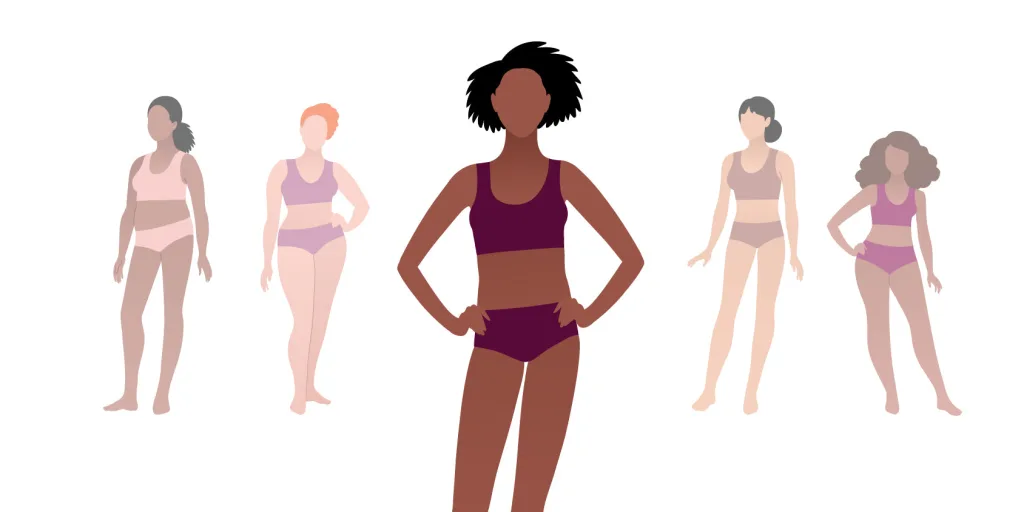The term body habitus refers to the overall shape and size of the human body, and is a major factor in determining medical imaging outcomes. It is an important concept for medical practitioners to understand, and can be used to accurately diagnose and treat illnesses or injuries.
Body habitus can be divided into three distinct categories: hypersthenic, sthenic, and asthenic. Hypersthenic individuals are those with a large frame or heavy set build. This body type has more mass than average, typically with larger organs such as a heart that has an axis nearly transverse. Sthenic individuals have an average build, with organs that are typically at midline or slightly off-center. Asthenic individuals are those with an extremely thin physique, usually with smaller organs than average.
It is important to note that body habitus can have a significant effect on medical imaging results and diagnostics. In ultrasound imaging, for example, the beam intensity can be significantly attenuated by the presence of fat in thicker layers. This can make it difficult for accurate clinical interpretations to be made from the images acquired. Similarly, in radiology reports large body habitus is often referred to in euphemistic terms like “large frame” as it can also affect image quality negatively.
Understanding body habitus is essential for medical practitioners as it provides valuable insight into how best to approach vaious diagnostic tests and treatments for their patients. By taking into account the overall shape and size of the individual being examined, practitioners can better tailor their methods for maximum accuracy and efficiency in diagnosis and treatment planning.
The Meaning of Body Habitus
Body habitus is a medical terminology used to describe a person’s body type or physical build. It can refer to the overall shape and size of the body, including height, weight, and proportions. It does not always refer to fat; rather, it can also refer to someone who is very muscular or tall. While large body habitus may sometimes be used as a euphemism for overweight/obese patients in radiology reports, it is important to note that this term encompasses all body types, not just those with excess body fat.

Types of Body Habitus
The four types of body habitus are hypersthenic, sthenic, hyposthenic and asthenic. Hypersthenic describes a person with a large frame or heavy set body. Sthenic refers to the average person whose body type is neither too thin nor too heavy. Hyposthenic is used to describe someone who is very small or smaller than average. Finally, asthenic is used to describe an extremely tiny body habitus.
Common Body Habitus
The most common body habitus is known as sthenic. This body type is characterized by a symmetrical physique with balanced proportions and a healthy weight relative to height. People with sthenic body habitus typically have well-defined muscles, an even distribution of fat, and good posture. The organs of this body type tend to be well-positioned, with the heart sitting at the midline of the chest in nearly vertical position. Sthenic body habitus is typically seen in people who exercise regularly, eat a healthy diet, and maintain a balanced lifestyle.
The Importance of Body Habitus in Radiography
Body habitus is important in radiography because it can affect the accuracy of the images. The larger the body habitus, the more tissue there is between the X-ray source and the body part being examined. This can reduce the amount of radiation that reaches the body part and therefore reduce image quality. Without a clear image, it can be difficult for radiologists to accurately diagnose a patient’s condition. In addition, larger body habitus can also increase radiation exposure to both patient and operator, which should be avoided whenever possible.
Effects of Body Habitus on Organs
Body habitus is a term used to describe the body shape and size of an individual. It has direct implications for the location and functioning of many of the body’s organs.
The heart is the most important organ affected by body habitus, as its size and position are determined by the amount of fat surrounding it. In people with a larger body habitus, the heart may be pushed to one side or may be located lower in the chest cavity than in people with a smaller body habitus.
The lungs are also affected by body habitus, as their position relative to other organs depends on how much fat is present around them. People with larger body habituses usually have more fat surrounding their lungs, leading to reduced lung capacity and breathlessness.
The diaphragm is another organ that is directly influenced by body habitus. As fat accumulates around this muscle, it reduces its ability to contract and expand properly durig respiration, leading to difficulty breathing in some cases.
The stomach and colon are two other organs that can be affected by body habitus due to their close proximity to each other. When more fat accumulates between these two organs, it can cause them to become displaced from one another which can lead to digestive issues such as acid reflux or constipation.
The gallbladder is also affected by body habitus due its close proximity to other organs such as the liver and pancreas which can become displaced due to excess fat accumulation around them. This displacement can lead to problems such as gallstones or jaundice.
In summary, organs directly affected by body habitus include the heart, lungs, diaphragm, stomach, colon and gallbladder. These organs may experience displacement or reduced functioning due to excess fat accumulation around them which can lead to serious health complications if not treated properly.

Types of Body Fat
The four types of body fat are essential, subcutaneous, visceral, and intramuscular. Essential fat is necessary for the normal functioning of the body and is found in small amounts in muscle, bone marrow, and organs. Subcutaneous fat is located directly under the skin and provides insulation. Visceral fat surrounds organs like the heart, liver, and intestines. Intramuscular fat is found within muscles and helps to cushion them against injury. All types of fat are important for maintaining good health and should be consumed in moderation.
Alternative Word for Habitus
Habitus is a term used to describe the physical characteristics of an individual, such as their body shape, size, posture, and overall physique. Other words that can be used to describe habitus are frame, shape, build, conformation, form, constitution, proportions, and structure. All of these terms refer to the physical aspects of a person’s body and how it is put together.
Classifying Difficult Body Habitus
The body habitus that is most difficult to classify is called hyposthenic, or slender. This body habitus refers to individuals who have very little body fat, low muscle mass and narrow shoulders. They may also have a small frame and be of a height that is shorter than average. This type of body habitus can be difficult to distinguish from certain other types, such as ectomorphic, becuse they may appear very similar. Additionally, due to the lack of body fat on this type of person, it can be hard to accurately tell whether they are hyposthenic or not without measuring their muscle mass and other markers of health.
Stomach Habitus: Lowest Body Habitus
The lowest position of the stomach is seen in persons with an asthenic habitus. In this body type, the stomach is vertical and its most dependent portion extends well below the transpyloric, or interspinous, line. This means that the bottom of the stomach can reach further down than in other body types. Additionally, this type of body habitus may be characterized by thin limbs, narrow shoulders and chest, and a lack of energy or fatigue.

The Importance of Understanding Body Habitus in Positioning
Understanding body habitus is important to positioning beause it helps the technologist determine the optimal angle and field size to get the clearest image. Different body shapes require different positioning adjustments in order to capture all of the relevant anatomy and ensure that no artifacts are present. For example, an obese patient may need a larger field size than an average-sized patient in order to ensure that their entire abdomen is visible. Additionally, patients with a tall stature may need a more angled x-ray beam in order to view their lungs and heart properly without overexposing other structures. Properly adjusting for body habitus helps produce accurate diagnostic images.
Common Body Habitus in the Population
The most common body habitus present in about 50% of the population is known as Sthenic body habitus. It is characterized by a balanced and symmetrical physique, with neither excessive fat nor muscle mass. The body proportions are normal, the posture is upright and the limbs have a normal length and angle. People with this body habitus tend to have good muscle tone, a well-developed chest, broad shoulders and long legs. They tend to be active and healthy with good balance and coordination.
Redundant Bowel Loops and Body Habitus
Hyposthenic or Asthenic body habitus is likely to have redundant bowel loops. This body habitus is characterized by a low BMI, small frame size, and a thin build. These individuals tend to have excess skin and fat around the abdomen which leads to extra folds in the intestines, resulting in redundant bowel loops. Individuals with this type of body habitus may also experience gastrointestinal symptoms such as bloating, gas and cramping due to the extra folds of intestines.
What is Habitus in Simple Terms?
Habitus is a term used to refer to the way of life or “habits” of a cetain social group or class. It encompasses the norms, values, attitudes, and behaviours that define how members of this group interact with each other and with society at large. Habitus refers to the unspoken social rules that people learn from their family, peers, and community; it is a set of assumptions about what is accepted and desirable in their culture. Habitus also includes the physical environment in which people live and work, such as housing, transportation, education, employment opportunities, etc. By understanding habitus, we can better understand how different social groups interact with one another and how they are affected by the socio-economic conditions of their environment.
Can Habitus Be Transformed?
Yes, habitus can be changed. Habitus is a concept developed by French sociologist Pierre Bourdieu that describes the internalized habits, dispositions, and tendencies that shape an individual’s behavior and attitudes. It is not a fixed trait or skill, but rather something that is formed through socialization in response to the vrious experiences individuals come across in their lives. While it may be difficult to completely change one’s habitus, it is possible over time for it to evolve as individuals gain new experiences and learn new skills. This can happen when individuals are exposed to different situations or environments and actively seek out opportunities to practice what they have learned. As this process continues, old-structured dispositions can be replaced with new ones in a creative motion directly related to an individual’s habitus.
Examples of Habitus
Habitus is a concept developed by sociologist Pierre Bourdieu to refer to the way an individual’s life experiences shape their behavior and attitudes. It is a combination of learned habits, skills, and dispositions that are rooted in our socialization and form our identities.
An example of habitus could be the way a person dresses. Different social groups have different dress codes, so someone’s clothing choices can give clues about their class, ethnicity, or oter cultural influences. In addition to clothing, the way a person speaks—their accent, dialect, and style of speaking—can also reveal aspects of their identity. Furthermore, body language can also indicate what kind of environment a person has been exposed to; someone who is used to being around other people may have a more open posture than someone who is more timid or shy. Additionally, certain skills and hobbies can be acquired through upbringing or education; for example, if someone grew up playing classical music they may be more proficient at playing instruments than someone who hasn’t had formal lessons. Finally, values can also be shaped by family and culture; for instance, some families emphasize the importance of hard work while others may place emphasis on creativity or spiritual exploration.
Conclusion
In conclusion, body habitus is a medical term used to refer to an individual’s physical body type. It is typically divided into four categories: hypersthenic, sthenic, hyposthenic and asthenic. Each category has its own distinct characteristics and organs can be paced in each according to their shape and size. Large body habitus can have a detrimental effect on medical imaging modalities, especially ultrasound where the beam intensity can be significantly attenuated due to thick layers of fat. It is important for healthcare professionals to understand the implications of body habitus when interpreting imaging results in order to make accurate clinical interpretations.
